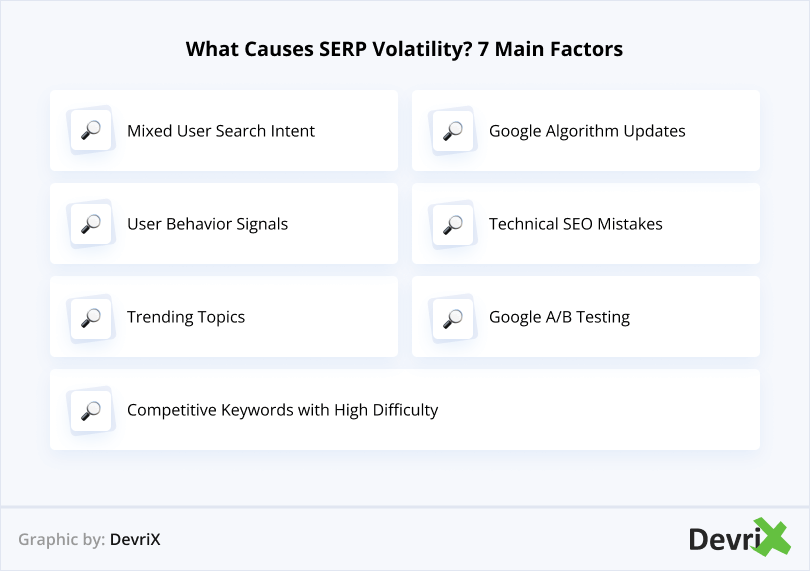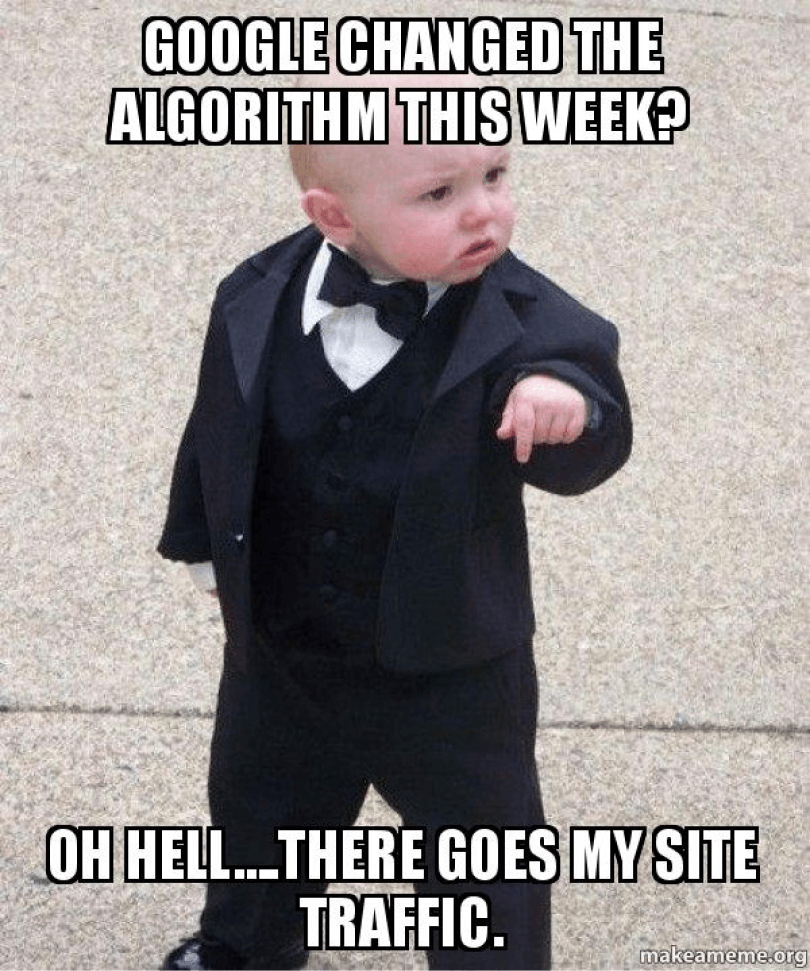Search engine result pages (SERPs) are extremely important for the online presence of every website. Simply put, the more searches where your website appears in the top 10 search results, the more organic traffic, and exposure your site gets.
In a perfect world, once you occupy the first place for a specific search, you would remain there forever. However, the world is far from perfect, so there is no guarantee that you won’t be number one today, and number twenty tomorrow.
This process is referred to as SERP volatility, and it is completely normal.
Readers Also Enjoy: How Does Google Search Work? [Complete Tutorial]
What Is SERP Volatility?
SERP volatility refers to the drastic increase or decrease in pages that target certain keywords. Having so many websites competing for the top spot among the search results means that there will frequently be changes regarding who gets top billing.
SERP fluctuations are not just random occurrences – they’re indicative of the search engine’s ongoing efforts to refine and optimize the user experience. These fluctuations can be influenced by a myriad of factors, including but not limited to algorithm updates, shifting market trends, and changes in user search patterns.
This also leads to the logical conclusion that the more search results there are for a certain query, the higher the keyword fluctuation will be. Yet, what are the factors that decide which page will be placed first, second, and so on?
In other words, what causes SERP volatility? Let’s find out.
Readers Also Enjoy: Keyword Mapping for SEO: The Ultimate Guide – DevriX
What Causes SERP Volatility? 7 Main Factors

- Mixed User Search Intent
- Google Algorithm Updates
- User Behavior Signals
- Competitive Keywords with High Difficulty
- Technical SEO Mistakes
- Trending Topics
- Google A/B Testing
1. Mixed User Search Intent
Google places a lot of emphasis on matching the outcome to its user search intent.
For example, people who search for “quick cake recipes”, expect to find websites that provide said recipes. Here, it would be nonsensical to display sites that sell cakes.
However, sometimes search intent is a bit mixed, and it is hard for Google to immediately understand what users are searching for, and what type of results they expect to see.
Let’s take the term “doors”. The search intent is unclear since you have results about the band “The Doors”, types of doors that exist, and various businesses selling interior/exterior doors.
Ultimately, without the user clarifying what they are looking for, Google cannot decide which of the three is relevant to their search.
Readers Also Enjoy: How to Pick the Right Keywords for Your Content – DevriX
2. Google Algorithm Updates
Google has changed a lot in the last 25 years. Naturally, it is all for the sake of delivering the best possible user experience. Modifications to how Google Search works are being made constantly, yet there are also some bigger updates, known as algorithm updates.
They can be quite scary, just ask any SEO specialist. The biggest reason for this is what happens after these updates. Will the changes be advantageous for their websites or disastrous? You never know.

Anyway, Google algorithms are a common reason why SERP volatility occurs since the changes in ranking factors can often lead to major changes in keyword rankings, search intent, SERP features, and so on.
Readers Also Enjoy: Google Helpful Content Update [People > Bots] – DevriX
3. User Behavior Signals
Understanding user behavior is never an easy task. More so, when it comes to analyzing the behavior of thousands of people.
Nonetheless, Google tries to provide the best user experience possible, by pushing the most relevant results to the top.
In practice, this means that, according to Google, certain pages are getting:
- More clicks
- Higher average session durations
- Lower bounce rates
- Higher engagement rates
As these are also a clear indication that these pages are preferred by users, they should therefore be ranked higher due to the relevancy.
Readers Also Enjoy: User Behavior Analysis 101: Definition, Tools, and Types of Behavior – DevriX
4. Competitive Keywords with High Difficulty
Another common reason for SERP volatility is high difficulty keywords with a lot of competition. Unlike low competition keywords that are much easier to rank for, high-difficulty keywords are one – very hard to rank, and two – regularly fluctuating.
For example, the keyword “sports”, has a keyword difficulty of 100, and a search volume of over 200,000. Trying to rank for it will be almost impossible, not to mention it is quite vague.
Instead, you might want to target a keyword that is more descriptive and has a lower difficulty. For instance, if you want to sell sports accessories, that term has a keyword difficulty of 66, and a volume of 1300, so you are much more likely to rank higher for it.
This is because there are millions of pages trying to rank for the same search terms and any newer, or fresher content that appears, can lead to a change in the ranking positions. Sometimes on a weekly, or even daily basis.
A good way to decide whether you have any chance to rank well for a high-difficulty keyword is to consider the authority score of your domain. Additionally, if your rankings go down suddenly, you should analyze the SERPs to check whether there are any newer articles or fresher content. That would be a sign that you should also update your own pages.
Readers Also Enjoy: 7 Incredibly Useful Keyword Gap Analysis Tips for Small Businesses – DevriX
5. Technical SEO Mistakes
Sometimes, a loss in keyword rankings could be entirely your own fault. Technical SEO mistakes that could cause SERP volatility include:
- Changing URLs. URL slugs are an important part of SEO. You must always consider your rankings when updating your URLs since a change in the URL means that Google will have to re-crawl, and re-index the page.
- Keyword cannibalization. Having multiple pages with similar content that all target the same keyword can lead to keyword cannibalization. Always try to avoid it, as it could hurt your rankings, since Google will try to rank all such pages for the same keyword, meaning that they will be fighting each other.
- Updating content. Changing and updating website content is a necessity, yet you should be prepared for a drop in ranking. Keep in mind to check your current rankings before you update, and try to keep high-performing keywords.
- Migrating your website. Moving your website to a new domain means that Google will have to crawl and index your content all over again. The best way to avoid this is to optimize your pages, and set redirects from your old pages to new ones.
- Slow loading website. If your pages are taking too long to load, people will stop interacting with them. This in turn will signal to search engines that your pages should be ranked lower which will affect not only your rankings but your website traffic as well. It is best to find out why your pages are loading slower and resolve the issues as soon as possible.
Readers Also Enjoy: 13 Crushing eCommerce Website SEO Problems to Avoid [2022] – DevriX
6. Trending Topics
Trending topics can change everything within minutes. A very good example of this would be “King Charles”. Before the death of Queen Elizabeth and the coronation of Charles, the results were mainly about the King Charles Spaniel dog breed.
Therefore, any websites ranking high for the term “king charles” (Spaniel) would have received a sudden drop in ranking.
Additionally, this could lead to SERP feature volatility, since features like People Also Ask will rank different pages.
Readers Also Enjoy: How to Find Trending Topics Online? [Tips & Tools] – DevriX
7. Google A/B Testing
Google conducts A/B testing of SERPs with the goal of delivering the latest, most relevant information to users.
This happens quite frequently for terms like “ChatGPT”. These terms are constantly being flooded with thousands of articles and new information.
So, the SERPs are being regularly updated, and a web page can potentially change its position several times a week.
Readers Also Enjoy: Zero Click Searches – How Is 0 Better Than 1? – DevriX
How Can You Track SERP Volatility?
In the context of SERP fluctuations, businesses must stay informed and agile. The digital world is fluid, with trends and user preferences evolving rapidly.
This constant state of flux means that keywords and content that perform well today might not yield the same results tomorrow. Adapting to SEO volatility requires a proactive approach, where regular analysis and updates become part of the SEO routine.
The good news is that if you want to better understand and handle SERP volatility, you can use tools to monitor changes. Here are some of the tools you can use to track volatility in SERPs:
- Semrush Sensor – Google’s rank and algorithm tracking tool
- SERP Volatility Index – Wincher.com
- Check Daily SERP Volatility Insights | Mangools
- Rank Risk Index – Google SERPs Volatility
This proactive stance not only helps in mitigating the impacts of SERP volatility but also opens up opportunities for capturing new traffic and audiences as search patterns evolve.
Readers Also Enjoy: What Is SEO Forecasting [How Can It Help Your Business Grow?] – DevriX
Summary
SERP volatility is not something that should depress you. Instead, you should see it as an opportunity to understand the reasons for the fluctuations and use it to rank your pages higher.
You need to also accept that it might not always be up to you whether you can combat the volatility or not. In such cases, stay calm and don’t panic, try analyzing the situation, and adapting your strategy, so you can rule the SERPs once again. You can do it!




